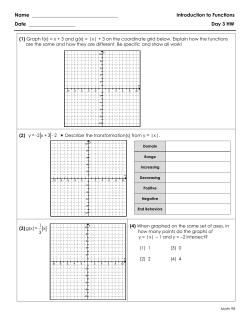
Slides
Massive-Scale Graph
Analysis
Vinay Setty
Siaram Gurajada
Mohamed Yahya
Stephan Seufert
[vsetty, gurajada, myahya, sseufert]@mpi-inf.mpg.de
Agenda
•
Introduction
•
Topics
•
Seminar rules and requirements
•
Registration
Overview
•
Fridays 10:00 - 11:30 in E 1.4 / R 021
•
Today (24th April 2015) kickoff meeting
•
8th May 2015 to 10th July 2015 your seminars
•
No holidays on seminar days!
gion Graph (STRG). The STRG can handle both temporal
and spatial characteristics of video data. It is defined as
follows:
Definition 2. Given a video segment S, a SpatioTemporal Region Graph, Gst(S), is a six-tuple Gst(S) =
{V, ES , ET , ∫, ª, ø }, where
Graphs Are Sexy!
• V is a finite set of nodes for segmented regions from S,
• ES µ V £ V is a finite set of spatial edges between adjacent
nodes in S,
• ET µ V £ V is a finite set of temporal edges between temporally consecutive nodes in S,
• ∫ : V ! AV is a set of functions generating node attributes,
T
sub
D
{V 0
ther
• ª : ES ! AES is a set of functions generating spatial edge
attributes,
• ø : ET ! AET is a set of functions generating temporal
edge attributes.
Social Graphs
In an STRG, a temporal edge (eT 2 ET ) represents the
relationships between two corresponding nodes (regions) in
two consecutive frames, such as velocity (how much their
centroids are changed) and moving direction. Figure 2 shows
part of STRG for frames #104 ° #106 in a sample video.
Protein toaThe
Protein
horizontal lines between the frames indicate the temporal(PPI)
edges.
Knowledge Graphs
Interactions
D
grap
and
phic
N
mos
eac
com
6.
D
grap
only
|G|
T
neig
Co-author, Citation Graphs
Frame #104
Frame #105
Frame #106
Video Scenes [Lee SIGMOD’05]
D
nod
jace
Massive-Scale Graphs
•
Web Graphs: trillions of nodes and edges
•
•
•
Clue web: 4.7 billion web pages and 8 billion links
Social Graphs
•
Facebook: 1.25 billion monthly active users with hundreds of billions of
relationships (as of March 31, 2015)
•
Twitter: 288 million monthly active users
Knowledge Graphs
•
Google knowledge graph: 570 million nodes 18 billion facts
•
Freebase: 1.9 billion triples
Graph Algorithms
•
Page Rank
•
Shortest paths
•
Connected components (strongly and weakly connected
components)
•
Traversal (BFS, DFS)
•
Enumerating triangles (for computing clustering
coefficient)
•
Graph matching
Topic 1: Map/Reduce for
Graphs
•
08/05/2015
•
Cohen: Graph twiddling in a MapReduce world, Computing in Science & Engineering 2009
•
Lin and Schatz: Design patterns for efficient graph algorithms in MapReduce, Workshop on
Mining and Learning with Graphs 2010
•
Additional Reference (to introduce Map/Reduce) Lin et al.: Data-intensive text processing with
MapReduce, 2010
•
Preferred background: Databases, Knowledge of Map/Reduce, fundamental graph algorithms
•
What is expected:
•
•
Present the Map/Reduce paradigm
•
Clearly explain all the the graph algorithms and their implementations using Map/Reduce
paradigm
•
Must cover both papers in detail
Tutor: Sairam Gurajada
Topic 2: Graph Analysis
Using Map/Reduce
•
15/05/2015
•
Kang et al.: Pegasus: A peta-scale graph mining system implementation and observations,
ICDM 2009
•
Kang et al.: PEGASUS: mining peta-scale graphs, Knowledge and Information Systems 2011
•
Preferred background: Databases, Knowledge of Map/Reduce, fundamental graph algorithms,
matrix operations
•
What is expected:
•
•
Build on and relate to previous topic
•
Focus on second paper (first paper is a subset of the second paper)
•
Clearly explain the matrix multiplication implementation and graph algorithms in Pegasus
•
Discuss evaluations
Tutor: Sairam Gurajada
Topic 3: Pregel
•
22/05/2015
•
Malewicz et al.: Pregel: a system for large-scale graph processing, SIGMOD 2010
•
Salihoglu and Widom: Optimizing Graph Algorithms on Pregel-like System, VLDB 2014
•
Additional Reference: McCune et al.: Thinking Like a Vertex: a Survey of Vertex-Centric Frameworks for
Large-Scale Distributed Graph Processing., ACM Computing Surveys 2015
•
Preferred background: Databases, Distributed Systems, Message Passing model, Bulk Synchronous Parallel
(BSP) model
•
What is expected:
•
•
Introduce BSP, contrast it to Map/Reduce model (Refer to Thinking Like a Vertex by McCune et. al. for
explanation of BSP and other communication models)
•
Explain Pregel architecture
•
Explain Pregel applications : graph algorithm implementations on Pregel in detail from second paper
•
Discuss evaluations
Tutor: Sairam Gurajada
Topic 4: GraphLab
•
22/05/2015
•
Gonzalez et al.: PowerGraph: Distributed Graph-Parallel Computation on Natural Graphs, OSDI 2012,
[Paper]
•
Low et al.: Distributed GraphLab: A Framework for Machine Learning and Data Mining in the Cloud,
VLDB 2012, [Paper]
•
Preferred background: Databases, Distributed Systems, Message Passing model, Map/Reduce, Pregel,
fundamental graph algorithms
•
What is expected:
•
•
Introduce GraphLab (second paper has better introduction)
•
Compare and contrast Pregel, GraphLab, PowerGraph, Hadoop
•
Explain distributed GraphLab applications (Netflix recommendation challenge, video co-segmentation,
Named entity recognition)
•
Discuss evaluations
Tutor: Stephan Seufert
Topic 5: Graph Partitioning
•
05/06/2015
•
Stanton and Kliot: Streaming Graph Partitioning for Large Distributed Graphs, KDD 2012, [Paper]
•
Tsourakakis et al.: FENNEL: streaming graph partitioning for massive scale graphs, WSDM 2014,
[Paper]
•
Preferred background: Databases, Algorithms and Datastructures
•
What is expected:
•
•
Introduce the problem of balanced graph partitioning
•
Explain the heuristics from the first paper (including METIS)
•
Introduce formalization of the graph partitioning problem (from FENNEL paper) if time permits
•
Explain the streaming algorithm
•
Discuss evaluations
Tutor: Mohamed Yahya
Topic 6: Large-Scale Graph
Engines
•
12/06/2015
•
Kyrola et al.: GraphChi: Large-Scale Graph Computation on Just a PC, OSDI 2012
•
Shao et al.: Trinity: A Distributed Graph Engine on a Memory Cloud., SIGMOD 2013,
•
Preferred background: Databases, Distributed Systems, Operating Systems
•
What is expected:
•
•
Present either GraphChi or Trinity in detail
•
If you want to present Trinity introduce GraphChi briefly
•
Explain the challenges of graph algorithms for evolving graphs and explain how they are
handled in GraphChi or Trinity
•
Discuss experiments
Tutor: Vinay Setty
Topic 7: Comparison of
Approaches
•
19/06/2015
•
Lu et al.: Large-Scale Distributed Graph Computing Frameworks: An Experimental Evaluation,
VLDB 2014
•
McCune et al.: Thinking Like a Vertex: a Survey of Vertex-Centric Frameworks for LargeScale Distributed Graph Processing., ACM Computing Surveys 2015
•
Preferred background: Databases, Distributed Systems, Operating Systems
•
What is expected:
•
•
Summarize all the presented approaches Pregel, GraphLab, GraphChi
•
Compare and contrast these approaches
•
Discuss experiments in detail
•
Use second paper (survey) mostly as additional reference to get more information
Tutor: Vinay Setty
Topic 8: RDF Graph
Processing
•
26/06/2015
•
Neumann et al.: RDF-3X: a RISC-style engine for RDF, VLDB 2008,
•
Huang et al.: Scalable SPARQL Querying of Large RDF Graphs, VLDB 2011
•
Preferred background: Databases
•
What is expected:
•
•
Introduce RDF and SPARQL briefly
•
Introduce RDF-3X discuss limitations
•
Explain the parallel SPARQL engine from second paper
•
Discuss experiments
Tutor: Mohamed Yahya
Topic 9: Graph Streams
•
03/07/2015
•
Aggarwal et al.: On dense pattern mining in graph streams., VLDB 2010
•
Chen et al.: Continuous Subgraph Pattern Search over Certain and Uncertain Graph
Streams, TKDE 2010
•
Preferred background: Databases, Algorithms and Data structures
•
What is expected:
•
•
Introduce graph stream processing
•
Explain (sub)graph isomorphism problem, approximate graph search and dense patterns
•
Briefly explain the approaches from both papers
•
Discuss evaluation
Tutor: Vinay Setty
Topic 10: Graph Algorithms: Dense
Subgraphs and Graph Sketches
•
10/07/2015
•
Angel et al.: Dense subgraph maintenance under streaming edge weight
updates for real-time story identification, VLDB 2014, [Paper]
•
Ahn et al.: Graph sketches: sparsification, spanners, and subgraphs, PODS
2012, [Paper]
•
Preferred background: Databases, Algorithms and Data structures
•
What is expected:
•
•
Pick one of the papers and present in detail
•
Someone comfortable with presenting theoretical analysis is preferred
Tutor: Mohamed Yahya
Presentation
•
45 minutes talk in English
•
Around 30 minutes of Q&A
•
Talk to your tutor at least 2 weeks before your talk
•
If you get the first topic you have to start now! (it is an easier
topic)
•
Prepare your own slides (keynote, power point or latex code must
be sent to your tutor)
•
You must send your slides to and discuss them with your tutor by
the Monday before your talk (by 16:00) at the latest, otherwise
your talk will be canceled (this is a hard deadline)
Guidelines for Presenting
•
It is important to clearly introduce the problem and the idea presented in the papers
•
In the papers look for:
•
Contributions of the paper
•
Improvements to the state-of-the-art
•
Main results
•
Conclusions and future work
•
Discuss the insights that are provided in the papers
•
Identify strengths and weaknesses, question the assumptions, criticize the bad
decisions in the papers
•
Refer to https://web.stanford.edu/~jacksonm/present.pdf
Report
•
Up to 8 pages using the template in the course web page
•
Maximum of 4 weeks after your talk
•
Contents of the report:
•
include the basic idea presented in the papers
•
summarize the papers
•
include the points raised in the seminar by the opponents (collaborate with
the opponents if necessary)
•
include the important results and conclusions
•
bonus points if you include the content from the papers outside of your
assigned papers (such as any follow up works, new results etc)
Opponents
•
Two opponents per talk
•
One of the opponents introduces the speaker
•
Other opponent moderates the Q&A session
•
Both opponents must read the papers thoroughly
•
prepare questions
•
challenge the ideas and results in the papers (if
there are any weaknesses)
Participation
•
Participation in all the talks is mandatory (not just
your own)
•
If you are sick please let us know in advance
•
•
If you miss more than two seminars you need to
provide a note from the doctor
Active participation is required (we will monitor on
who is active and who is not)
What counts for grade?
•
Your presentation 50%
•
Report 25%
•
Your performance as an opponent 15%
•
Active participation in the seminars 10%
Registration
•
Send an email to vsetty@mpi-inf.mpg.de
•
Your name, student number and semester
•
Your background: mention the relevant lectures you have taken,
any seminars you have taken
•
Three topics in the order of the their preference and a brief
explanation to show if you have any relevant background for that
topic
•
Maximum 10 participants
•
You will know the topic assignment by Monday, 27th April (may be
earlier)
© Copyright 2025








